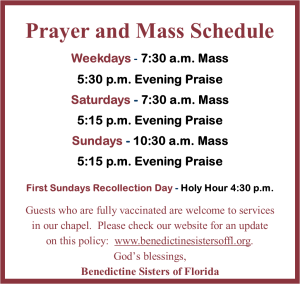celebration
Labor Day
 Next weekend our nation will be celebrating Labor Day. Strangely we honor it by the opposite of its name. In many respects it is a Workers Holiday. Labor Day was created by the labor movement in the late 19th century and became a federal holiday in 1894. Since then each year on the first Monday in September we pay tribute to the contributions and achievements of American workers. You may also know about the celebrations to honor employees on May 1st, the feast of St. Joseph the Worker. Here in our monastery we host our employees at a special THANK YOU luncheon in gratitude for the services and presence of our employees. The day is topped off with early release time. They disappear after lunch – it’s a paid half-day. That includes the cook for the evening meal. (Oh, dear!) Thankfully we have a long-time association with some loyal volunteers who take over the kitchen to provide a home-prepared FISH FRY with our favorite Southern trimmings: grits with butter or cheese, hush puppies, coleslaw and ice cream novelty bars for dessert; beer or soft drinks. God bless them EveryONE!
Next weekend our nation will be celebrating Labor Day. Strangely we honor it by the opposite of its name. In many respects it is a Workers Holiday. Labor Day was created by the labor movement in the late 19th century and became a federal holiday in 1894. Since then each year on the first Monday in September we pay tribute to the contributions and achievements of American workers. You may also know about the celebrations to honor employees on May 1st, the feast of St. Joseph the Worker. Here in our monastery we host our employees at a special THANK YOU luncheon in gratitude for the services and presence of our employees. The day is topped off with early release time. They disappear after lunch – it’s a paid half-day. That includes the cook for the evening meal. (Oh, dear!) Thankfully we have a long-time association with some loyal volunteers who take over the kitchen to provide a home-prepared FISH FRY with our favorite Southern trimmings: grits with butter or cheese, hush puppies, coleslaw and ice cream novelty bars for dessert; beer or soft drinks. God bless them EveryONE!
So in honor of all workers, even the tiniest among us, let’s talk a bit about workers and work styles. We often hear the expression “a little child shall lead.” With the opening of a new school year and Labor Day weekend fast upon us, it seems to me fitting that we let little children lead us to a rightful understanding of “work.”
For many years I enjoyed ministry as a Montessori directress in programs for children ages 6-months to 6-years. One of the observable differences between children and adults is the contrast between their attitudes toward work.
 Have you ever watched a toddler painstakingly build a tower of blocks and then gleefully knock it down, over and over? That’s “work.” Or have you been victim to the infant self-feeder who looks at her spoon held over space beyond the highchair tray, then flexes her little fingers so the spoon disappears as she peeks over the arm of the chair to gaze at the spoon on the floor. The adult carefully picks up the spoon – or if it is the third or fourth time snatches it up – wipes it off (or grabs a clean one from the drying rack) and places it within the child’s grasp. Now watch out of the corner of your eye while the child waits until you make eye contact, an impish grin appears as the spoon drops, once again, into outer space. Now, that’s “work.”
Have you ever watched a toddler painstakingly build a tower of blocks and then gleefully knock it down, over and over? That’s “work.” Or have you been victim to the infant self-feeder who looks at her spoon held over space beyond the highchair tray, then flexes her little fingers so the spoon disappears as she peeks over the arm of the chair to gaze at the spoon on the floor. The adult carefully picks up the spoon – or if it is the third or fourth time snatches it up – wipes it off (or grabs a clean one from the drying rack) and places it within the child’s grasp. Now watch out of the corner of your eye while the child waits until you make eye contact, an impish grin appears as the spoon drops, once again, into outer space. Now, that’s “work.”
The child’s desire to work represents a profound instinct. A child’s objective is the work itself and they eagerly repeat a task over and over. Mastery is what matters to them; they are their own taskmasters.
Unlike many adults, children do not follow the law of minimum effort. Their work consumes their every energy and at the same time it energizes them. Nor do children look for assistance but defend themselves from interference with great determination. Watch the two-year-old after mom buttons him up. He’ll undo every button and with full concentration re-button the shirt – it may hang lopsided but “I did it myself!”
Children, unlike most adults, are in no hurry to complete a task – they are not clock watchers. They seem to instinctively know that practice makes perfect and growth cannot be hurried. The ultimate end for which children are working is not consciously known to them but the happiness they radiate gives evidence of an inner contentment.
May each of you know the inner contentment you first experienced in early childhood. That deep sense of peace when you can say: “Ah, This is where I belong. I am doing what God created me to do at this time in my life.”


